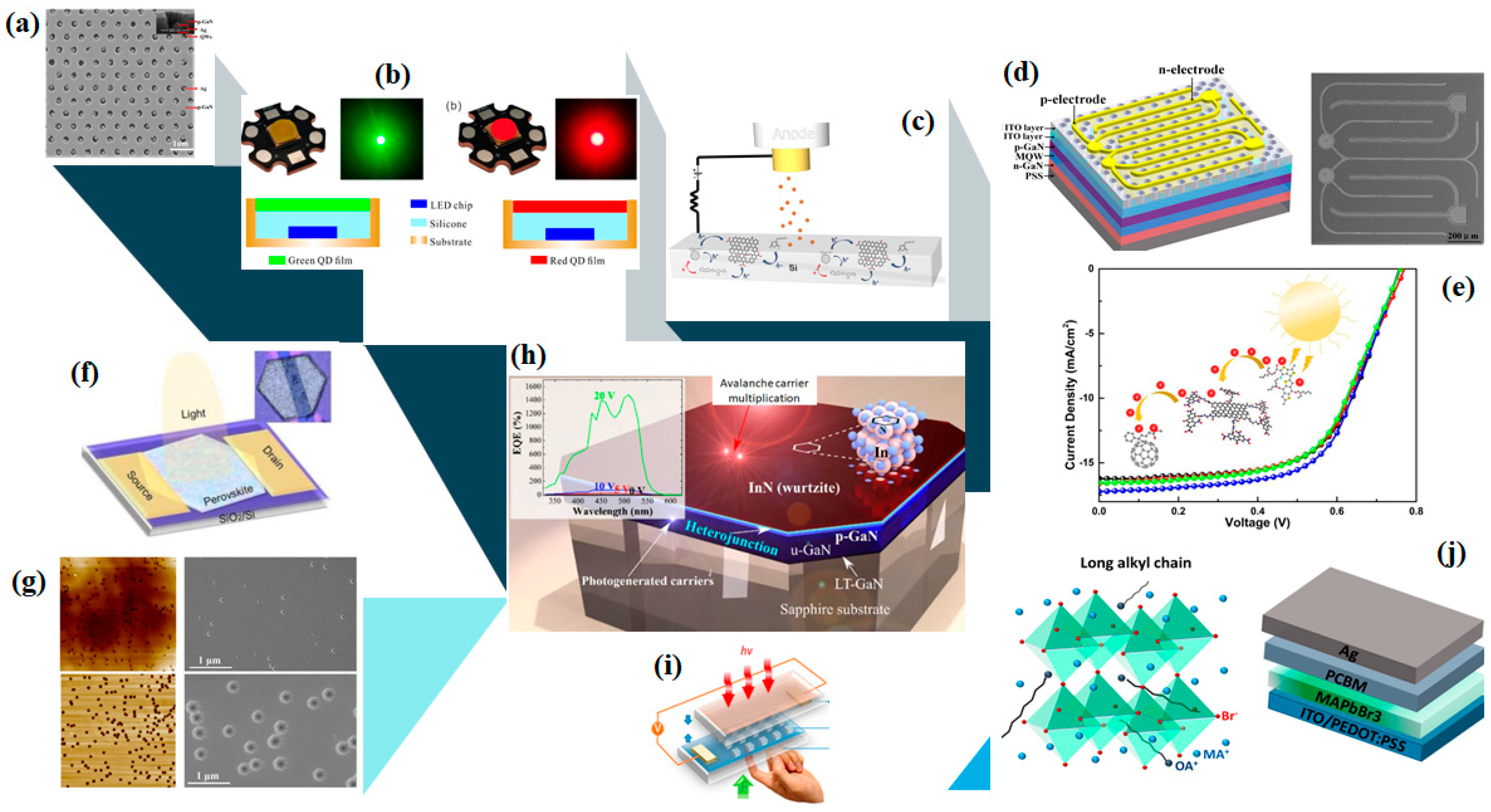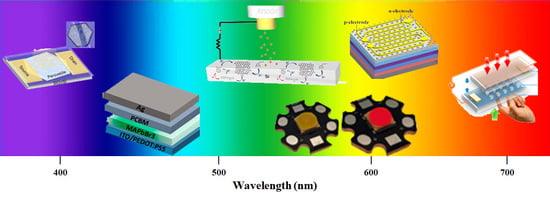Optoelectronic Nanodevices
Funding
Acknowledgments
Conflicts of Interest
References
- Cheng, J.; Wang, C.; Zou, X.; Liao, L. Recent Advances in Optoelectronic Devices Based on 2D Materials and Their Heterostructures. Adv. Opt. Mater. 2019, 7, 1800441. [Google Scholar] [CrossRef]
- Stylianakis, M.M.; Konios, D.; Kakavelakis, G.; Charalambidis, G.; Stratakis, E.; Coutsolelos, A.G.; Kymakis, E.; Anastasiadis, S.H. Efficient ternary organic photovoltaics incorporating a graphene-based porphyrin molecule as a universal electron cascade material. Nanoscale 2015, 7, 17827–17835. [Google Scholar] [CrossRef]
- Viskadouros, G.; Zak, A.; Stylianakis, M.; Kymakis, E.; Tenne, R.; Stratakis, E. Enhanced Field Emission of WS2 Nanotubes. Small 2014, 10, 2398–2403. [Google Scholar] [CrossRef]
- Stylianakis, M.M.; Maksudov, T.; Panagiotopoulos, A.; Kakavelakis, G.; Petridis, K. Inorganic and Hybrid Perovskite Based Laser Devices: A Review. Materials 2019, 12, 859. [Google Scholar] [CrossRef]
- Bao, Q.; Hoh, H.Y. 2D Materials for Photonic and Optoelectronic Applications, 1st ed.; Elsevier: Amsterdam, The Netherlands, 2019; pp. 1–336. [Google Scholar]
- Aslam, U.; Rao, V.G.; Chavez, S.; Linic, S. Catalytic conversion of solar to chemical energy on plasmonic metal nanostructures. Nat. Catal. 2018, 1, 656–665. [Google Scholar] [CrossRef]
- Noori, K.; Konios, D.; Stylianakis, M.M.; Kymakis, E.; Giustino, F. Energy-level alignment and open-circuit voltage at graphene/polymer interfaces: Theory and experiment. 2D Mater. 2016, 3, 015003. [Google Scholar] [CrossRef]
- Toma, A.; Zaccaria, P.R.; Krahne, R.; Alabastri, A.; Coluccio, M.L.; Das, G.; Liberale, C.; De Angelis, F.; Francardi, M.; Mecarini, F.; et al. Nanostructures for Photonics. In Encyclopedia of Nanotechnology; Bhushan, B., Ed.; Springer: Dordrecht, The Netherlands, 2016; pp. 2827–2843. [Google Scholar]
- Wen, Y.; He, P.; Yao, Y.; Zhang, Y.; Cheng, R.; Yin, L.; Li, N.; Li, J.; Wang, J.; Wang, Z.; et al. Bridging the van der Waals Interface for Advanced Optoelectronic Devices. Adv. Mater. 2019, 1906874. [Google Scholar] [CrossRef]
- Yan, W.; Dong, C.; Xiang, Y.; Jiang, S.; Leber, A.; Loke, G.; Xu, W.; Hou, C.; Zhou, S.; Chen, M.; et al. Thermally drawn advanced functional fibers: New frontier of flexible electronics. Mater. Today 2020. [Google Scholar] [CrossRef]
- Ou, Q.; Bao, X.; Zhang, Y.; Shao, H.; Xing, G.; Li, X.; Shao, L.; Bao, Q. Band structure engineering in metal halide perovskite nanostructures for optoelectronic applications. Nano Mater. Sci. 2019, 1, 268–287. [Google Scholar] [CrossRef]
- Feng, Y.; Chen, Z.; Jiang, S.; Li, C.; Chen, Y.; Zhan, J.; Chen, Y.; Nie, J.; Jiao, F.; Kang, X.; et al. Study on the Coupling Mechanism of the Orthogonal Dipoles with Surface Plasmon in Green LED by Cathodoluminescence. Nanomaterials 2018, 8, 244. [Google Scholar] [CrossRef]
- Yan, C.; Du, X.; Li, J.; Ding, X.; Li, Z.; Tang, Y. Effect of Excitation Wavelength on Optical Performances of Quantum-Dot-Converted Light-Emitting Diode. Nanomaterials 2019, 9, 1100. [Google Scholar] [CrossRef] [PubMed]
- Stylianakis, M.M.; Viskadouros, G.; Polyzoidis, C.; Veisakis, G.; Kenanakis, G.; Kornilios, N.; Petridis, K.; Kymakis, E. Updating the Role of Reduced Graphene Oxide Ink on Field Emission Devices in Synergy with Charge Transfer Materials. Nanomaterials 2019, 9, 137. [Google Scholar] [CrossRef]
- Zhao, J.; Ding, X.; Miao, J.; Hu, J.; Wan, H.; Zhou, S. Improvement in Light Output of Ultraviolet Light-Emitting Diodes with Patterned Double-Layer ITO by Laser Direct Writing. Nanomaterials 2019, 9, 203. [Google Scholar] [CrossRef] [PubMed]
- Stylianakis, M.M.; Kosmidis, D.M.; Anagnostou, K.; Polyzoidis, C.; Krassas, M.; Kenanakis, G.; Viskadouros, G.; Kornilios, N.; Petridis, K.; Kymakis, E. Emphasizing the Operational Role of a Novel Graphene-Based Ink into High Performance Ternary Organic Solar Cells. Nanomaterials 2020, 10, 89. [Google Scholar] [CrossRef] [PubMed]
- Xue, Y.; Yuan, J.; Liu, J.; Li, S. Controllable Synthesis of 2D Perovskite on Different Substrates and Its Application as Photodetector. Nanomaterials 2018, 8, 591. [Google Scholar] [CrossRef] [PubMed]
- Liu, M.; Zhao, J.; Zhou, S.; Gao, Y.; Hu, J.; Liu, X.; Ding, X. An InGaN/GaN Superlattice to Enhance the Performance of Green LEDs: Exploring the Role of V-Pits. Nanomaterials 2018, 8, 450. [Google Scholar] [CrossRef]
- Svrcek, V.; Kolenda, M.; Kadys, A.; Reklaitis, I.; Dobrovolskas, D.; Malinauskas, T.; Lozach, M.; Mariotti, D.; Strassburg, M.; Tomašiūnas, R. Significant Carrier Extraction Enhancement at the Interface of an InN/p-GaN Heterojunction under Reverse Bias Voltage. Nanomaterials 2018, 8, 1039. [Google Scholar] [CrossRef]
- Lee, D.J.; Mohan Kumar, G.; Ilanchezhiyan, P.; Xiao, F.; Yuldashev, S.; Woo, Y.D.; Kim, D.Y.; Kang, T.W. Arrayed CdTe Microdots and Their Enhanced Photodetectivity via Piezo-Phototronic Effect. Nanomaterials 2019, 9, 178. [Google Scholar] [CrossRef]
- Chen, L.-C.; Tseng, Z.-L.; Lin, D.-W.; Lin, Y.-S.; Chen, S.-H. Improved Performance of Perovskite Light-Emitting Diodes by Quantum Confinement Effect in Perovskite Nanocrystals. Nanomaterials 2018, 8, 459. [Google Scholar] [CrossRef]
- Deng, J.; Wang, M.; Song, X.; Yang, Z.; Yuan, Z. Ti Porous Film-Supported NiCo2S4 Nanotubes Counter Electrode for Quantum-Dot-Sensitized Solar Cells. Nanomaterials 2018, 8, 251. [Google Scholar] [CrossRef]
- Ho, W.-J.; Liu, J.-J.; Yang, Y.-C.; Ho, C.-H. Enhancing Output Power of Textured Silicon Solar Cells by Embedding Indium Plasmonic Nanoparticles in Layers within Antireflective Coating. Nanomaterials 2018, 8, 1003. [Google Scholar] [CrossRef] [PubMed]
- Shi, L.; Cui, Y.; Gao, Y.; Wang, W.; Zhang, Y.; Zhu, F.; Hao, Y. High Performance Ultrathin MoO3/Ag Transparent Electrode and Its Application in Semitransparent Organic Solar Cells. Nanomaterials 2018, 8, 473. [Google Scholar] [CrossRef] [PubMed]
- Chen, L.; Zhang, H.; Zhang, J.; Zhou, Y. A Compact and Smooth CH3NH3PbI3 Film: Investigation of Solvent Sorts and Concentrations of CH3NH3I towards Highly Efficient Perovskite Solar Cells. Nanomaterials 2018, 8, 897. [Google Scholar] [CrossRef] [PubMed]
- Li, J.; Tang, Y.; Li, Z.; Ding, X.; Yu, S.; Yu, B. Improvement in Color-Conversion Efficiency and Stability for Quantum-Dot-Based Light-Emitting Diodes Using a Blue Anti-Transmission Film. Nanomaterials 2018, 8, 508. [Google Scholar] [CrossRef]
- Zhou, Q.; Wang, H.; Xu, M.; Zhang, X.-C. Quantum Efficiency Enhancement of a GaN-Based Green Light-Emitting Diode by a Graded Indium Composition p-Type InGaN Layer. Nanomaterials 2018, 8, 512. [Google Scholar] [CrossRef]
- Jin, X.; Trieu, S.; Chavoor, G.J.; Halpin, G.M. Enhancing GaN LED Efficiency through Nano-Gratings and Standing Wave Analysis. Nanomaterials 2018, 8, 1045. [Google Scholar] [CrossRef]
- Wang, H.; Zhou, Q.; Liang, S.; Wen, R. Fabrication and Characterization of AlGaN-Based UV LEDs with a ITO/Ga2O3/Ag/Ga2O3 Transparent Conductive Electrode. Nanomaterials 2019, 9, 66. [Google Scholar] [CrossRef]
- Tang, B.; Miao, J.; Liu, Y.; Wan, H.; Li, N.; Zhou, S.; Gui, C. Enhanced Light Extraction of Flip-Chip Mini-LEDs with Prism-Structured Sidewall. Nanomaterials 2019, 9, 319. [Google Scholar] [CrossRef]
- Shih, C.-K.; Ciou, Y.-T.; Chiu, C.-W.; Li, Y.-R.; Jheng, J.-S.; Chen, Y.-C.; Lin, C.-H. Effects of Different Oxidation Degrees of Graphene Oxide on P-Type and N-Type Si Heterojunction Photodetectors. Nanomaterials 2018, 8, 491. [Google Scholar] [CrossRef]
- Shi, L.; Liang, Q.; Wang, W.; Zhang, Y.; Li, G.; Ji, T.; Hao, Y.; Cui, Y. Research Progress in Organic Photomultiplication Photodetectors. Nanomaterials 2018, 8, 713. [Google Scholar] [CrossRef]
- Guo, Z.; Xu, H.; Guo, K.; Shen, F.; Zhou, H.; Zhou, Q.; Gao, J.; Yin, Z. High-Efficiency Visible Transmitting Polarizations Devices Based on the GaN Metasurface. Nanomaterials 2018, 8, 333. [Google Scholar] [CrossRef] [PubMed]
- Ma, Q.; Zhan, Y.; Hong, W. Tunable Metamaterial with Gold and Graphene Split-Ring Resonators and Plasmonically Induced Transparency. Nanomaterials 2019, 9, 7. [Google Scholar] [CrossRef] [PubMed]
- Wu, J.; Du, Y.; Xia, J.; Zhang, T.; Lei, W.; Wang, B. Dynamically Tunable Light Absorbers as Color Filters Based on Electrowetting Technology. Nanomaterials 2019, 9, 70. [Google Scholar] [CrossRef] [PubMed]
- Ma, Z.; Meng, X.; Liu, X.; Si, G.; Liu, Y.J. Liquid Crystal Enabled Dynamic Nanodevices. Nanomaterials 2018, 8, 871. [Google Scholar] [CrossRef]
- Celebrano, M.; Ghirardini, L.; Finazzi, M.; Ferrari, G.; Chiba, Y.; Abdelghafar, A.; Yano, M.; Shinada, T.; Tanii, T.; Prati, E. Room Temperature Resonant Photocurrent in an Erbium Low-Doped Silicon Transistor at Telecom Wavelength. Nanomaterials 2019, 9, 416. [Google Scholar] [CrossRef]

© 2020 by the author. Licensee MDPI, Basel, Switzerland. This article is an open access article distributed under the terms and conditions of the Creative Commons Attribution (CC BY) license (http://creativecommons.org/licenses/by/4.0/).
Share and Cite
Stylianakis, M.M. Optoelectronic Nanodevices. Nanomaterials 2020, 10, 520. https://doi.org/10.3390/nano10030520
Stylianakis MM. Optoelectronic Nanodevices. Nanomaterials. 2020; 10(3):520. https://doi.org/10.3390/nano10030520
Chicago/Turabian StyleStylianakis, Minas M. 2020. "Optoelectronic Nanodevices" Nanomaterials 10, no. 3: 520. https://doi.org/10.3390/nano10030520
APA StyleStylianakis, M. M. (2020). Optoelectronic Nanodevices. Nanomaterials, 10(3), 520. https://doi.org/10.3390/nano10030520





